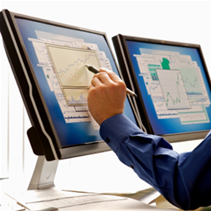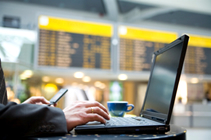Back in 2005 the FBI reported that the losses due to laptop theft were estimated around $3.5 million. They also identified that the average cost associated with a lost company laptop was around $32,000. Since 2005 the number of laptop users has dramatically increased and it has been assessed that one in ten laptops have or will be stolen. Laptop protection has become a major concern for many laptop users. The threat that laptop thieves pose is more than just concern for our expensive devices, it triggers our fear that someone could have access to our stolen and vital personal information.
Laptop theft is a significant and serious threat. Thieves will often target laptops because they are small, easy to grab, easy to conceal, there is a market for them, and they are a quick way to get cash. Most of these criminals target laptops because they know that a property theft charge is a better alternative to a personal robbery charge. Once stolen, a laptop can then be sold to a used computer store or pawn shops for as much as half the original retail costs.
What can you do to secure your laptop? There are two components to laptop security, the physical side and the virtual. Physical protection refers to instinctual protection like keeping your laptop with you, keeping it out of sight as well as purchasing protection devices such as cable locks, laptop safes, and motion detector alarms. Virtual security on the other hand implies defenses such as software protection programs, passwords, and tracking safeguards.
The following guide is intended to identify security techniques and tools to protect you from being a victim of a laptop theft. The tips will cover practical security methods, virtual defense techniques, and physical protection devices. For the best protection it is recommended that you use a combination of each.
Practical Security Tips:
- Never leave your laptop unattended or in plain sight.
- Keep your laptop in a secure, or hidden place
- Lock your doors and windows when you’re not in your room.
- Never leave your laptop in an unlocked vehicle.
- If you leave it in your vehicle make sure that it the car is locked and the laptop is out of sight. The best place is in a locked trunk or covered in the back seat.
- Write down your laptop’s serial number.
- Don’t store sensitive content on your laptop.
- Don’t share your passwords and make sure that they are sufficient.
- Don’t store your passwords. A lot of programs now have the option to remember passwords. It may make it easier for you to access your information but if stolen it will also make it that much easier for criminals to gain access to your accounts.
- Personalize the look of your laptop with clear identifiable marks.
- Carry your laptop in a nondescript carrying case, briefcase, or bag. Placing it in a case designed for computers is an immediate alert to thieves that you have a laptop.
- Lock the laptop in your office during off-hours.
- Back up your information on disks and store the disks at home or the office.
- Pay attention to where you use your laptop. Be aware that someone behind or next to you can see your computer screen.
- At airport checkpoints, be observant. Don’t place the laptop on a conveyor belt until you are ready to walk through the checkpoint.
Physical Protection Tips:
- Sometimes just having some type of security device attached to your laptop is a good enough deterrent for thieves.
- When you have to leave your laptop unattended you can store it in a Laptop Locker. These safes secure your device whether it’s in your office, car, or home.
- When out in public or in a shared office you can use a laptop Cable Lock. Using a laptop security cable is one of the easiest methods of laptop security and protects against theft. Click on the link to see some cable lock options.
- Another option for securing your laptop is to have a secured bracket or a docking station. A security bracket or dock bolts your laptop in a stationary location either in its open or closed position.
- If there isn’t a structure to attach your cable lock then you could always use a Motion Sensor Alarm.
- A STOP Security Plate will also prevent criminals from stealing your device. These stickers have a unique barcode for each laptop and user. If the sticker is removed it reveals a permanent “Stolen Property” mark and provides a number to report the theft.
- Check out devices with Biometrics like finger print or retina scanners.
- You can also use a Privacy screen to ensure you are the only viewer able to see your information. Privacy screens limit the angle at which the computer screen is visible.
Virtual Defense Tips:
- Although user passwords are not nearly as effective as they once were, it doesn’t hurt to still use them.
- Encrypt your sensitive documents.
- Use Full or Whole Disk encryption. This is software that encrypts the data on the entire disk including the Bootable Operating System partitions. Disk encryption software does not encrypt the Master boot Record. However certain Disk encryption hardware will encrypt everything including the MBR.
- Purchase Remote Laptop Security software so that you can deny access rights to someone trying to access your stolen device.
- See if your device is eligible for laptop insurance from Safeware.com.
- Use a Theft Recovery Software.
- Set up a BIOS password. The BIOS software is built into the PC, and it is the first code that a computer runs when powered on. Establishing a password in the BIOS will ensure that a laptop thief will be unable to load the Operating System unless they acquire the correct credentials. This Pre-Boot Authentication guarantees a secure environment that is external to the operating system. Pre-Boot Authentication is confirmed with something you know (username or password), something you have (smart card or other token), or something you are (biometric data).
How to establish a password in BIOS:
1. Start or restart your computer. When the BIOS screen comes on, press the Delete key to enter BIOS setup. (Some computers used “F12? or “F2”, or other keys)
2. Use the arrow keys to choose “Security” and press Enter. You will then see “Supervisor Password” and “User Password” on your screen.
3. Use the arrow keys to move down and highlight “Set User Password”, Press Enter. Enter the password in the password field and enter the password again in the confirm password field when it appears. Press Enter to set the password.
4. Use the arrow key to move down and highlight “Set Password Check”, press Enter. The options to invoke the password during “Setup” or “Always” will then appear. Choosing “Setup” requires a password to enter the BIOS. Choosing “Always” requires a password every time you start your computer. Highlight your choice and press Enter.
5. Press Esc one time, use the arrow key to select “Exit”, press Enter. Save your changes and exit. Your computer will then exit the BIOS screen and reboot.
When a laptop is stolen the actual loss can be huge. The replacement cost of a stolen laptop includes the cost of the new laptop, any stolen peripheral devices (network cards, modems), replacement software, time to configure the new device, and time to install new software. Not to mention any work material, photos, purchased media, memories, and personal information are now history. Any stored information on your computer is vulnerable and even if laptop thieves can’t benefit from the sale of your computer they could potentially gain access to personal information or your online accounts. If you aren’t already utilizing some of these suggestions or devices we strongly urge you to do so immediately, overlooking the importance of laptop security could be huge mistake.
Check out companies like Kensington, Targus, and Lenovo for the latest in laptop security.
Have a Great Day!
Dustin









